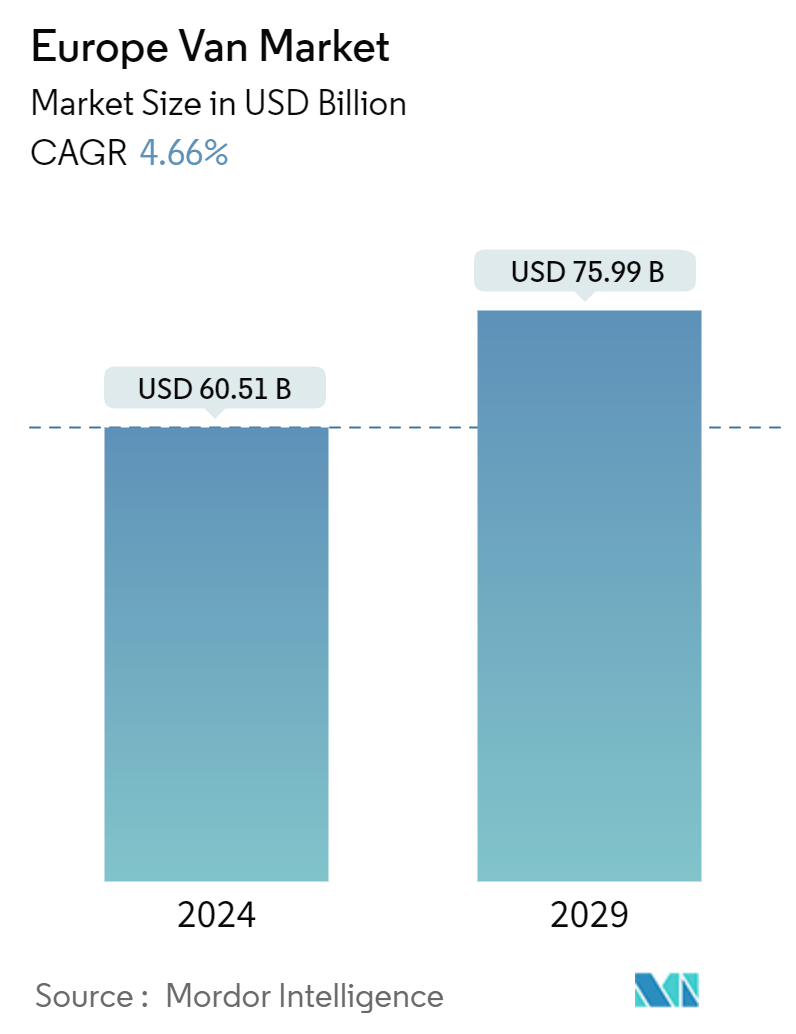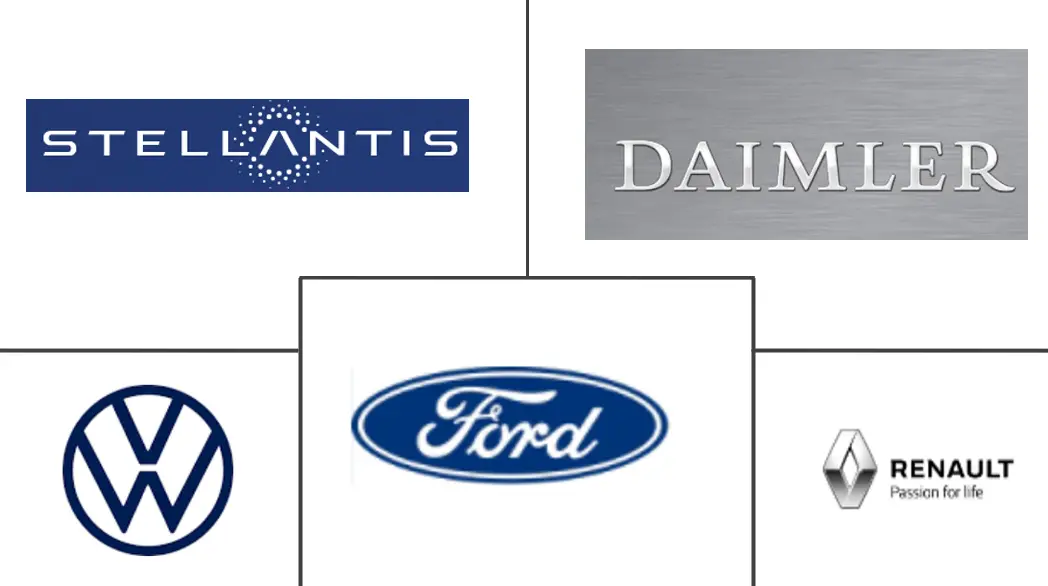Market Size of Europe Van Industry

| Study Period | 2019 - 2029 |
| Base Year For Estimation | 2023 |
| Market Size (2024) | USD 60.51 Billion |
| Market Size (2029) | USD 75.99 Billion |
| CAGR (2024 - 2029) | 4.66 % |
| Market Concentration | High |
Major Players
*Disclaimer: Major Players sorted in no particular order |
Europe Van Market Analysis
The Europe Van Market size is estimated at USD 60.51 billion in 2024, and is expected to reach USD 75.99 billion by 2029, growing at a CAGR of 4.66% during the forecast period (2024-2029).
The European van market is significant, with steady growth driven by increasing demand for commercial vehicles in urban and rural areas. Vans are essential for various industries, including logistics, construction, and retail, where they serve as versatile workhorses for transporting goods and services.
Technology is pivotal in transforming the European van market. Integrating advanced telematics, GPS tracking, and IoT (Internet of Things) in modern vans enhances fleet management and operational efficiency. These technologies provide real-time data on vehicle performance, fuel consumption, and route optimization, which is crucial for businesses aiming to reduce operational costs and improve productivity.
Electric vans are gaining traction as a sustainable alternative to conventional diesel vans. Major manufacturers like Mercedes-Benz, Renault, and Ford are investing heavily in developing and producing electric vans, addressing the growing demand for eco-friendly transportation solutions. Introducing models, like the Mercedes-Benz eSprinter and Renault Kangoo ZE, signify the market's move toward electrification.
The regulatory landscape in Europe is a significant factor influencing the van market. The European Union has implemented stringent emission standards, such as the Euro 6 regulations, which mandate lower emissions for all new vehicles. These regulations are pushing manufacturers to innovate and adopt cleaner technologies. Additionally, European cities have introduced low-emission zones, where only cars meeting specific emission criteria can operate. This has accelerated the adoption of electric and hybrid vans as businesses seek to comply with these regulations and avoid penalties.
The surge in e-commerce is a primary driver, with online shopping becoming increasingly popular. This has led to a rise in demand for efficient last-mile delivery solutions, where vans are the preferred mode of transportation. Companies like Amazon, DHL, and UPS are expanding their van fleets to meet the increasing demand for quick and reliable delivery services.
Urbanization is another key driver. As more people move to cities, a higher demand for goods and services necessitates efficient urban logistics. Vans are ideal because they can navigate narrow city streets and deliver directly to consumers.
Despite the positive growth trajectory, the European van market faces several challenges. One significant challenge is the high cost associated with electric vans. Although the total cost of ownership for electric vans can be lower in the long run due to savings on fuel and maintenance, the initial purchase price remains a barrier for many small and medium-sized enterprises (SMEs).
Infrastructure is another challenge. The availability of charging stations for electric vans is still limited in many parts of Europe, posing a hurdle to widespread adoption. Additionally, the range anxiety associated with electric vehicles, where users fear running out of charge before reaching their destination, continues to be a concern.
The European van market is poised for substantial growth, driven by the surge in e-commerce, urbanization, and technological advancements. As the market evolves, businesses can adapt to changing consumer demands and regulatory requirements and are expected to be well-positioned to thrive in this dynamic environment.
Europe Van Industry Segmentation
A van is an enclosed wagon or motortruck used for the transportation of goods.
The European van market is segmented by cargo space (more than 5 cubic meters and less than 5 cubic meters), end user (commercial and government), drive type (IC engine, electric, and alternative fuel), and geography (Germany, United Kingdom, Italy, France, Spain, and Rest of Europe).
The report offers market size forecasts for vans in Europe in terms of value (USD) for all segments.
| By Cargo Space | |
| More than 5 Cubic Meter | |
| Less than 5 Cubic Meter |
| By End User | |
| Commercial | |
| Government |
| By Drive Type | |
| IC Engine | |
| Electric | |
| Alternative Fuel |
| By Geography | |
| Germany | |
| United Kingdom | |
| Italy | |
| France | |
| Spain | |
| Rest of Europe |
Europe Van Market Size Summary
The European van market is experiencing steady growth, driven by increasing demand for commercial vehicles across various sectors such as logistics, construction, and retail. Vans are crucial for transporting goods and services, and their versatility makes them indispensable in both urban and rural areas. The market is being transformed by technological advancements, with the integration of telematics, GPS tracking, and IoT enhancing fleet management and operational efficiency. The shift towards electric vans is gaining momentum, with major manufacturers like Mercedes-Benz, Renault, and Ford investing in eco-friendly transportation solutions to meet the growing demand for sustainable options. The regulatory landscape, including stringent emission standards and low-emission zones, is further propelling the adoption of electric and hybrid vans as businesses strive to comply with environmental regulations.
The surge in e-commerce and urbanization are key drivers of the European van market's growth. The increasing popularity of online shopping has heightened the demand for efficient last-mile delivery solutions, where vans are the preferred mode of transportation. Urbanization necessitates efficient urban logistics, and vans are well-suited for navigating narrow city streets. Despite challenges such as the high cost of electric vans and limited charging infrastructure, the market is poised for substantial growth. France stands out with its significant market size, supported by a robust economy and well-developed infrastructure. French automakers are at the forefront of innovation, investing in advanced technologies to enhance van efficiency and sustainability. The competitive landscape is evolving, with major OEMs and new entrants like Arrival Electric Group Limited driving the market forward, particularly in the electric van segment.
Europe Van Market Size - Table of Contents
-
1. MARKET DYNAMICS
-
1.1 Market Drivers
-
1.1.1 Rise in Sale of Electric Vans is Driving the Market's Growth
-
-
1.2 Market Restraints
-
1.2.1 High Cost of Electric Vehicle Battery is Anticipated to Restrain the Market's Growth
-
-
1.3 Industry Attractiveness - Porter's Five Forces Analysis
-
1.3.1 Threat of New Entrants
-
1.3.2 Bargaining Power of Buyers/Consumers
-
1.3.3 Bargaining Power of Suppliers
-
1.3.4 Threat of Substitute Products
-
1.3.5 Intensity of Competitive Rivalry
-
-
-
2. MARKET SEGMENTATION
-
2.1 By Cargo Space
-
2.1.1 More than 5 Cubic Meter
-
2.1.2 Less than 5 Cubic Meter
-
-
2.2 By End User
-
2.2.1 Commercial
-
2.2.2 Government
-
-
2.3 By Drive Type
-
2.3.1 IC Engine
-
2.3.2 Electric
-
2.3.3 Alternative Fuel
-
-
2.4 By Geography
-
2.4.1 Germany
-
2.4.2 United Kingdom
-
2.4.3 Italy
-
2.4.4 France
-
2.4.5 Spain
-
2.4.6 Rest of Europe
-
-
Europe Van Market Size FAQs
How big is the Europe Van Market?
The Europe Van Market size is expected to reach USD 60.51 billion in 2024 and grow at a CAGR of 4.66% to reach USD 75.99 billion by 2029.
What is the current Europe Van Market size?
In 2024, the Europe Van Market size is expected to reach USD 60.51 billion.

